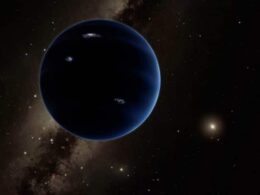The Leonid meteor shower has now officially begun, though rates will be low until the third week of November. The good news is that there will be no moonlight to hamper observing in 2020. Here is some helpful advice on what will happen.


The shower, also simply known as the Leonids, is a display of shooting stars that occurs every year, in November. It varies in strength and is produced by dust grains shed by a comet known as 55P/Tempel-Tuttle.
The meteors are known as Leonids because their flight-paths, when traced backwards, appear to radiate from a point in the constellation of Leo.
In 2020, observing conditions for the Leonids around the peak night on November 17th/18th are ideal because the Moon is close to new phase.
Rates are predicted to be low, with 10 to 15 meteors an hour visible at the peak. Under even the darkest skies, observers will only see a handful of meteors an hour in most years. But occasionally there is a meteor storm and hundreds of thousands rain down at its peak.
Such major displays are exceptional and have happened at approximately 33-year intervals, around the time that the parent comet is near perihelion (the closest point in its orbit to the Sun) in the inner Solar System.
They have probably happened far back in history, but the earliest clear record of exceptional activity was made in 1799. The first storm that hit the headlines happened in 1833 when the sky was filled with falling meteors for a time. It happened during darkness over the USA where the spectacle was widely seen.
The event was important in astronomy because it led scientists to consider that this natural firework show was produced by a cloud of objects arriving from space, rather than a purely atmospheric phenomenon.
A similar storm occurred in 1866, and this time it peaked during night time in Europe, from where many observers reported seeing hundreds of meteors an hour, including a number of bright fireballs.
Expectations were great for a repeat spectacle in 1899, but observers were disappointed when nothing out of the ordinary was seen. There are no reports of exceptional activity around 1932-3 either.
However, following the rediscovery of Tempel-Tuttle in 1965, it was calculated that the comet would make its closest approach to Earth since 1833. A year later, on November 17, 1966, a fantastic meteor storm was seen for an hour or so from the USA, with rates reaching many hundreds a minute at its peak.

There was high activity again a third of a century later, with storms in 1999 and 2001, plus high activity in 2000 and 2002 too. A big surprise was a night rich with numerous Leonid fireballs in 1998, a year before the predicted storm. Meteor experts subsequently worked out that the Earth had ploughed through a filament of meteoroids ejected by the comet in 1333!
A number of separate streams of dust from the comet now cross the Earth’s orbit at different times as they themselves orbit the Sun. The distribution of the dust in space gradually changes due both to the gravitational pull of planets, particularly mighty Jupiter, and the pressure of radiation from the Sun.

Sadly, another storm is not likely to happen until 2099, according to meteor scientists’ latest forecasts, though there is likely to be enhanced activity around 2031 and 2064 when the comet next returns. But observers should always be prepared for the unexpected as the Leonids have been known to spring surprises.
Tempel-Tuttle’s extended elliptical path brings it about as close to the Sun as the Earth before it recedes to a point beyond the orbit of Uranus. The comet itself is named after the two men who independently discovered it – German astronomer Wilhelm Tempel in December 1865, and American Horace Parnell Tuttle, in January 1866.
When can I see the Leonid meteor shower?
The limits of activity quoted by the International Meteor Organization are from November 6th to November 30th, so you could spot a Leonid at any time between those dates. However, most meteors will be seen in the third week of the month, with a peak in the morning hours of the night of November 17th/18th. The meteors appear swift in the sky, and the brighter ones are known to leave persistent trains, or a glow, in their wake.
What is the best way to observe the Leonids?
You do not need any optical equipment to see meteors, other than your own eyes. It is important to be comfortable. November nights can be very cold, so wrap up warm in suitable clothing, and to lie back in a deckchair or sun lounger to give you a good view of the sky.
Meteors appear at random, not regular intervals, so you will need to have patience when watching for the Leonids. You may not see anything for many minutes and then see another one or two in quick succession before another long wait. We have more advice on how to observe a meteor shower plus tips on how to photograph a meteor shower.



